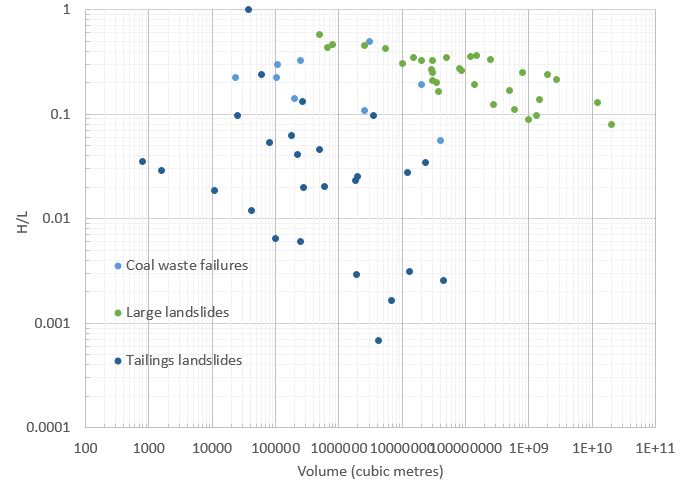10 February 2020
The exceptional mobility of tailings dam failures
Posted by Dave Petley
The exceptional mobility of tailings dam failures
I’m continuing to write my paper for the keynote at the 13th International Symposium on Landslides in Colombia this year (the paper is due this month, so the pressure is on). As I noted in a post last week, I’ve been looking at the impact of landslides in less developed countries; one key component of this is the impact of failures associated with mining.
As part of this work I’m taking a look at the mobility of tailings failures in relation to other major landslides. Tailings dam failures inflict a huge impact in terms of loss of life, environmental effects and social damage. It is well established that the impacts can extend for tens or even hundreds of kilometres downstream – the Ok Tedi tailings failure in Papua New Guinea for example extended for 1,000 km and disrupted the lives of 50,000 people. Of course much of this damage was caused by remobilisation of the tailings by the river, but the issue of the runout of the landslide itself is very pertinent.
A good way to analyse the runout of landslides is to examine the so-called Fahrböschung angle, which is the ratio between the vertical change of the landslide (from crown to toe) to the length of the landslides (again from crown to toe). More mobile landslides have a lower Fahrböschung angle.
Using case studies described in the World Mine Tailings Failures (2020) catalogue, and going back to original topographic and satellite data, I have been able to calculate the Fahrböschung angle for 27 tailings dam failures. I have then compared these with the mobility of large landslides using data presented in a famous paper (Legros 2002) a couple of decades ago. I have also included in the graph data for coal waste landslides:-

Graph of the Fahrböschung angle against volume for tailings dams and large landslides from Legros (2002).
.
Taking the large landslides first, it is well-known that the Fahrböschung angle decreases as landslide volume gets larger – the reasons for this remain a little unclear. Interestingly the same effect is seen for coal waste landslides and for tailings landslides, both of which are more mobile than large landslides. But, most significantly, the tailings landslides have a far lower Fahrböschung angle than that of the large landslides, but with much greater scatter too. Indeed, in many cases the Fahrböschung angle is two orders of magnitude lower – in other words, tailings landslides travel far further than other large landslides.
The reason for this high mobility is likely to the nature of the materials that are released in the tailings dam failure. Typically, the failure involves materials that have been crushed and that, at the point of failure, are saturated and have undergone liquefaction. The extreme mobility at the time of failure was of course illustrated rather elegantly by the Brumadinho failure in Brazil. Interestingly, many investigations of tailings dam failures tend to focus on the failure mechanism, and to ignore what happens thereafter. This needs attention.
Reference
2002. The mobility of long‐runout landslides, Engineering Geology, 63, 301– 331.


 Dave Petley is the Vice-Chancellor of the University of Hull in the United Kingdom. His blog provides commentary and analysis of landslide events occurring worldwide, including the landslides themselves, latest research, and conferences and meetings.
Dave Petley is the Vice-Chancellor of the University of Hull in the United Kingdom. His blog provides commentary and analysis of landslide events occurring worldwide, including the landslides themselves, latest research, and conferences and meetings.
Hi Dave, interesting research. Please let me know if you’d like any satellite-related contributions from me/CGG.
(1) Will your paper be correlating tailings dam failures with the tailings dam construction method (e.g., Upstream, Centreline, and Downstream methods)? (2) Upstream method perimeter dam raising is typically achieved by moving beach deposited tailings (which has an undefined particle size distribution, and therefore an undefined/uncontrolled percolation rate and may “hold” water which adversely affects the material strength). And more disturbingly, the upstream method perimeter dam moves progressively toward the “centre” of the tailings impoundment, and placed over previously deposited beach material containing fine particles which tend to “hold” water and lower the material strength upon which the dam is raised upon. (3) Centreline and Downstream methods are typically constructed using plus 200# (mesh, ~ 70 microns) and ideally the cyclones producing this material can be adjusted such that the dam building material contains less than 15% minus 200#, which in turn produces material with a sufficiently high percolation rate to minimize the water content of the perimeter dam, and enhance the stability/strength of the perimeter dam. Brazil/Chile have banned Upstream method. Even in BC Canada, Upstream method continues. It seems that the particle size distribution is an important characteristic related to the stability of tailings impoundments: the “exceptional mobility” of tailings dam failures could have a correlation with the particle size distribution of the tailings material stored behind the perimeter dam? For example, higher % fine particle content and ability to “hold” water over long periods of time.
The run-out data for tailings dams needs to be treated with some caution.
This is because what we typically have is a failure/flow of liquefied tailings, in conjunction with a release of supernatant water.
The water release carried entrained tailings as sediment for long distances. This is often (mostly?) reported as tailings flow.
But it is not the same thing, and should not be treated as tailings run-out.
Note there are some well established (and quite simple) methods for estimating tailings run-out. The real trick is the assessment of what values of liquefied strength to use as input to the models.